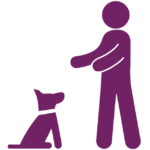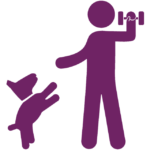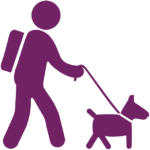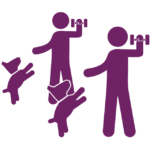PRIVATE DOG
TRAINING
Address Unwanted Ones
If you found yourself here, you most likely have a reactive dog. It.is.rough. You have to overly prepare to go on walks (at least if you don’t have a yard), even for just short potty breaks, and you are always on the lookout for your dog’s triggers: people, other dogs, cars, bicycles, the list can go on and on. You are on edge, your dog is on edge, and people “walking” their dogs off-leash or who leave their dogs unattended in yards are your nemesis…and rightfully so.
This is the time when a dog is most impressionable. They can learn skills that will set them up for success later, like calmly greeting other dogs and being allowed to politely play (if desired/allowed, but certainly not with every.single.dog. they see), or they can learn bad habits, like pulling to greet other dogs and engaging in poor play.
First, let’s talk about what is a reactive dog and what are the most popular tools for helping them.

Cornell Richard P. Riney Canine Health Center defines a reactive dog as:
[A dog] who overreacts to normal situations that other dogs would take in stride. Reactive dogs are not necessarily aggressive dogs, but reactivity can turn into aggression, so your attention to training becomes extremely important. Reactive dogs become overly aroused by common stimuli.
In other words, a reactive dog can be:
In a nutshell, the major key to helping rehabilitate a reactive dog is using desensitization and counter-conditioning through short, managed (i.e. working in a purposely chosen public space where you know you have several available exits and other dogs are on leash), if not controlled (i.e. working in a non-public space with a chosen neutral, on-leash dog), training sessions. Rehearsing and reinforcing a desired, calm response allows a new conditioned emotional response, or CER, to be established over time.
Great! Now let’s talk about those terms a bit more.
Desensitization
Science Direct defines desensitization as, “a psychological process by which a response is repeatedly elicited in situations where the action tendency that arises out of the emotion proves to be irrelevant.”
In other words, with repeated exposure to the trigger, one, including your dog, tends to react less intensely. However, desensitization alone does not rehabilitate a reactive dog. In order to help your dog feel, and thus react differently to their triggers, counter-conditioning should also be integrated.
Counter-Conditioning
Merriam-Webster defines counter-conditioning as, “conditioning in order to replace an undesirable response (such as fear) to a stimulus (such as an engagement in public speaking..or for your dog, seeing another dog) by a favorable one.”
So if your dog is currently barking at the delivery person out the window, you would need to practice (and reward!) an alternate, desired behavior, like sitting calmly on the couch when they hear your gate open and a package drop on your steps. This is what I call the master’s degree level behavior. For any new desired behavior, it’s important to start your dog in kindergarten. In this case, rewarding your dog for sitting calmly on the couch without any distractions, and then over time, gradually adding playing a recording of your gate opening on the lowest level, and rewarding your dog’s calmness.
Conditioned Emotional Response (CER)
A conditioned emotional response is an automatic response to a stimulus that has been learned from past exposures and experiences (running to the window to bark at the delivery person). It is not a choice or actively thought about, it is an emotional and automatic reaction.
For example, how do you feel when you hear the ice cream truck coming down the street or the sight of a cup of coffee being poured? What about when you hear screeching tires or the sight of an ambulance? These are all conditioned emotional responses. At first, these sights and sounds were neutral, but in time you came to associate them with good or bad things, and now you have a conditioned emotional response (CER) and react/behave a certain way when you hear or see them. To feel differently about these experiences you would have to desensitize and counter-condition yourself slowly over time.

Reinforcement
A reinforcer increases the likelihood your dog will repeat a behavior. Your dog decides what is a reinforcer. A water-loving lab is going to love a bath after a short training session. A dog that hates the water, will not find this rewarding, and in fact may find it to be a punishment. My dog, Berlin, did not like string cheese. She tried it once, and spit it out, and refused to try it again. Fair enough. I don’t like bacon (shocking, I know). So, string cheese wasn’t used as a reinforcer in our training together. She LOVED white american cheese though and would happily do things in hopes of earning some. Hazzah!
Your dog can be reinforced by things you don’t give them too, like the environment. So, don’t be stingy about reinforcing the behaviors you like otherwise, your dog will go back to doing what works for them, like barking at the neighbor out the window. They’ll think, “Ooo, I barked, and they walked away. I’ll keep barking at them whenever I see them so they’ll leave.”
Rehearsal
If your dog gets rewarded for behaviors, even unwanted ones (remember, the environment can reward them whether you want it to or not), they will repeat them, because that is what is being reinforced. Remember, your dog decides what is a reinforcer, not you, and barking, jumping, humping, etc. can all be rewarding for your dog.
Rehearsal is setting up behavioral patterns and habits for your dog to repeat so they can practice and get rewarded for the desired response or behavior. For a reactive dog, the desired behavior should be calmness, not necessarily a sit or down, so it is vital to rehearse (and reward!) this behavior in short training sessions.
Ok, it’s time to talk about the most underused tool in reactive dog training: Negative reinforcement ?.
Many understand and easily utilize positive reinforcement…Giving something as a reward.
But let’s break that down.
In this context ‘positive’ doesn’t mean ‘good’ or ‘happy’, it means addition. In other words, something is added…like treats, toys, or petting.
Alright, what about reinforcement?
As described above, a reinforcer increases the likelihood a behavior is repeated and thus should be something your dog likes or even loves (i.e. treats, toys, petting). Remember, your dog decides what is a reinforcer!
So, positive reinforcement is adding something your dog likes to increase the likelihood they repeat a behavior.

However, here it’s the counterpart to positive, so it means subtract. In other words, with negative reinforcement, the bad is what we *don’t* encounter, which is what makes it rewarding to repeat the desired behavior.
Let’s look at a human example.
Do you like getting a sunburn ☀️? No, right? Do you put on sunblock to avoid a sunburn? I certainly hope so. That’s negative reinforcement. You avoided an aversive (sunburn) by putting on sunblock, so you’re more likely to put on sunblock again next time ? because that behavior was reinforced by you *not* getting burned.
So looking at the video of Neah below, when she sees a dog and remains ‘calm’, she’s getting both positively (high-value treats) and negatively (*not* getting worked up and stressed, at least not to the point of going over threshold) reinforced as we walk away from the trigger. In other words, the thing causing her stress is removed (subtracted), reinforcing her calmness.
In her head, this will eventually sound like, “Oo, there’s a dog. I’ll get rewarded for walking away from it,” and with time that distance she can remain calm around other dogs will get smaller and smaller. In fact, we’re already seeing a difference.
She flailed at the sight or sound of one…and at the time we lived in a busy downtown area where buses were unavoidable. Treats were not an option. She just wouldn’t take them, not matter how high-value it was. So, the only way to counter-condition her was to show her that we got to walk away from buses. The second she saw or heard one, I said, “Good” and we walked in the opposite direction or turned the corner away from it.
but slowly over time, as she learned the buses didn’t get closer, and her reactions reduced. In time, I was able to add treats to our calm retreat (positive and negative reinforcement…BAM!). Then, over the course of a few months, we didn’t have to turn around as quickly. She was able to get closer to the bus (and it to her since it was a moving vehicle after all) AND take treats. I didn’t ask nor did she have to sit or down or even look at me.

I’d love to help. Reach out to schedule your complimentary phone consultation so I can learn a bit more about you, your dog, and your dog training goals.
Eugene, Oregon & Online




Eugene, Oregon



